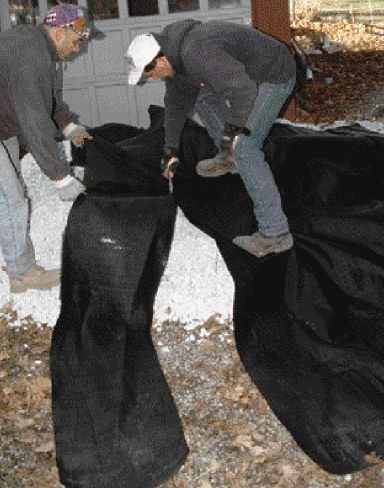Smarter Site Work with Geosynthetics, continued
Holes and ribs. Some geogrids are made by machinery that punches holes in a heavy sheet of polyethylene or polypropylene, then draws and stretches the material to create a framework of stiff ribs around openings 1 to 4 inches across. The stretching under controlled heat and pressure creates a strong plastic that can hold its shape under stress. Other companies use heavy plastic fibers to weave the grid pattern, and melt-bond or weave the intersections to create the screen structure.
But whatever the process, the products have similar engineering values. Their tensile strength and resistance to stretching give geogrids the ability to reinforce structural soils under roads, under foundations, and in earth walls. As with most geotech materials, the published values let the designer pick the material that’s right for the job; but most applications require a qualified engineer.
Geonets are like geogrids, but their crisscrossing strands overlap to form an open weave that allows drainage along the plane of the material. Geonets are strong enough to provide reinforcement the way geogrids do, but in practice they’re used almost entirely as sheet drainage materials, usually with filter-fabric facings to keep silt from clogging the weave. You won’t see them much in building construction — their biggest use is to line landfills and collect leachate — but they do turn up as drainage elements under rooftop gardens or concrete decks over occupied space.
Geocells
The U.S. Army Corps of Engineers developed the first “cellular confinement system” for gravel and soil in the 1970s as a way to build roads over soft ground (Figure 6). The grids of deep, tube-shaped cells keep loose material from spreading sideways, and spread vehicle loads over a wider area. In tests, heavy trucks made thousands of passes over a geocell roadbed with minimal rutting; without the system, the trucks quickly bogged down in the subgrade.
Figure 6.Cellular confinement systems, or geocells, lend great strength to roadbeds and embankments in heavy engineered applications. Gravel-filled Presto Geoweb geocell material provides a solid roadbed (top), while soil-filled Tenax Tenweb stabilizes a bank (center). Stacks of filled Terrafix Terraweb form a strong earth-retaining wall (bottom).
But roads aren’t the only use of geogrids. Stacks of geogrids can also make a strong earth-retaining wall, which can be seeded with plants on its face. And for light parking use, soil-filled cells provide protection for turf, so that cars won’t damage it (Figure 7).
Figure 7.Some geocell materials are designed for light-duty applications. This porous grass parking installation (GrassPave from Invisible Structures) provides a stable surface that can stand up to car traffic but avoids the need for storm drains by letting rain percolate into the ground.
Geocomposites
When you bond a layer of filter fabric to an open, free-draining component such as dimpled sheet plastic, drain tile, open-weave heavy geotextile, or geonet, you’ve got a geocomposite (Figure 8). These products provide a quick solution for site or foundation drainage and reduce the need for granular fill. Some products provide only drainage, while others can waterproof a foundation and provide drainage in one step. There are even specialized geocomposites designed for efficient venting of radon and other gases (Figure 9).
Figure 8.Geocomposite drainage systems, which combine a filter fabric with an open-weave web or dimpled sheet, provide high flow rates and quick installation. Some systems also provide waterproofing for foundations at the same time.
Figure 9.Besides fluid drainage, geocomposites can provide a vent for subsoil gases like radon, as in Colbond’s EnkaVent system. A dense mat of stiff nylon filaments bonded to a polyester filter fabric is placed on the prepared subgrade before the slab is poured; if radon is detected later, vent piping can be connected to the sub-slab air space to vent the gas to the outdoors.
But suppliers caution that if soils have heavy silt loading, the filters can become clogged. A soils engineer can provide appropriate details for specific site conditions; it’s a good idea in general to provide some coarse sand backfill in contact with the geotextile filter element (Figure 10). This combination of a sand filter and a fabric filter can be counted on for indefinite service.
Figure 10.Curtain drain systems can be more effective and quicker to build with geocomposite drainage components. Suppliers recommend a coarse sand backfill for filtration to prevent clogging of filter fabric. Flow rates can amount to hundreds of gallons a minute.
| Resources | |
Suppliers Amoco Fabrics and Fibers Co. 800/445-7732 BBA Nonwovens-Reemay Inc. 800/284-2780 http://www.typargeotextiles.com Belton Industries Inc. 800/225-4099 http://www.beltonindustries.com Boom Environmental Products 800/770-2666 Carthage Mills 800/543-4430 Colbond Geosynthetics The Netherlands http://www.geosynthetics.colbond.com Cosella-Drken 888/433-5824 Drainage Products Inc. 860/668-5108 Eljen Corporation 800/444-1359 http://www.eljen.com/index.html Evergreen Technologies Inc. 800/984-9784 Geo-Synthetics Inc. 800/444-5523 Greenfix America 760/348-7600 Huesker Inc. 800/942-9418 Invisible Structures, Inc. 800/233-1510 http://www.invisiblestructures.com Lun-Drain 800/948-5603 | North American Green 800/772-2040 Presto Products Co. 800/548-3424 Profile Products LLC 800/207-6457 http://www.profileproducts.com SI Geosolutions 800/621-0444 SolPlast, S.A. Spain (in Spanish) Tenax Corp. 800/356-8495 Tensar Earth Technologies Inc. 800/836-7271 Terrafix Geosynthetics Inc. 207/786-6808 WEBTEC Inc. 800/438-0027 Western Excelsior Corp. 800/833-8573 http://www.westernexcelsior.com For More Information Geosynthetic Materials Association 800/225-4324 Geosynthetic Research Institute 215/895-2343 Geosynthetica 561/265-0472 Industrial Fabrics Association International 800/225-4324 |
